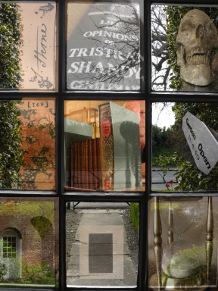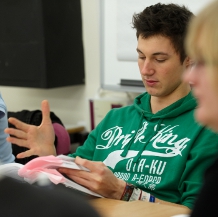Why study English in York?
At the Norwegian Study Centre, we offer a challenging and rewarding programme that makes active use of being in Britain to study English Literature, Linguistics and Culture. We are a small and friendly department with a proven record of excellence in teaching Norwegian students abroad. Our students benefit from the tremendous academic resources of the University of York, and the cultural richness of the historic city of York.
For information videos by the course tutors on individual courses, go here.
Why York?
Why choose the YorkCourse in English?
I am truly pleased to recommend the Norwegian Study Centre to anyone who is interested in high quality education in an excellent academic environment.
Where better to study English than in an English-Speaking environment and at a University which is considered to be one of the top in the UK and the world?
We are a small department of enthusiastic and committed teachers who seek to provide high quality education in a supportive and encouraging environment. Where possible, we try to incorporate the English-speaking environment, culture and current affairs into our teaching.
- You will learn from experts – our staff teach modules only in their specific subject or research areas.
- From day one you learn in a ‘hands-on’ approach, combining theory and practical exploration.
- You’ll get lots of help with essay-writing including one-to-one supervision sessions where you’ll have the chance to discuss your work in detail.
Facilities
As NSC YorkCourse students you will be students of the University of York entitling you to use all of the university's facilities - canteens, libraries, computer rooms etc.
The NSC also has a study room in Quantum House specifically for our students to study in and which also contains a majority of the NSC's YorkCourse library.
As a member of the university you will be issued with a University of York computing account. This account allows you access to the university's online facilities (library catalogue, electronic journals etc.) as well as providing you with a university email address and the ability to use any of the university's computer rooms. On arrival in York there will be a training session on computing at York which you can access via the Virtual Learning Environment (VLE). You can always get help from the IT Support Office, too.
In addition, the university - including the NSC - is Wi-Fi enabled.
The University of York Library houses an excellent collection of resources and in addition the NSC has a small library for exclusive use by our students.
Furthermore York is rich in other scholarly resources, which include the beautiful and stimulating Minster Library, and lots of good bookshops.
Whilst in York, our students can participate in a wide range of extra-curricular activities, and may also use the chance to develop interests in creative writing, music and drama, journalism, and a host of other activities.
Our Department
Studying at the NSC in York
Our Department
We are a small, open and friendly department with our own teaching rooms and offices on the edge of the main university Heslington West campus in a building called Quantum House.
Our teaching takes many forms: from one-to-one consultations with tutors, through small-group seminars, to larger workshops and lectures.
Tutors are always available for contact, and every YorkCourse student is also assigned an academic/pastoral supervisor who is available for advice and support on any aspect of university life.
For more information about staff and their research and teaching interests please visit our staff pages.
The University
York is consistently ranked as one of the top ten universities in Britain and one of the top 100 in the world.
The University of York is well-run with very good IT- and library services. The university area is nice and quiet with lots of green spaces and small waters – and a rich bird life, including black swans.
- It currently possesses a Gold Teaching Excellence Framework Award.
- The University was named THE (Times Higher Education) University of the Year in 2010, and has an international reputation for top-quality teaching and research.
- The University of York scores very highly in international university rankings, e.g. the neQS World University Rankings Subject Rankings 2019, with a UK top 10 and world top 25 ranking in English Language and Literature.
The Department of English and Related Literature
The literature component of our YorkCourse module is taught by staff from the Department of English and Related Literature.
The English department is an exceptionally lively and creative department with an innovative and forward-looking approach to teaching and assessment. They were ranked top in the UK for the quality of their research in the recent national assessments — so our students learn in the most stimulating and exciting academic environment possible.
Studying at York
Studying at York is a unique experience. Our academic quality, campus community, supportive staff and beautiful city make us an increasingly popular choice.
The University’s main campus is in Heslington, on the edge of the city. Here, colleges and departments are grouped around a large lake in 200 acres of landscaped parkland, creating a welcoming community feel. The NSC is based on the edge of the university campus and has its own teaching rooms and offices.
The college system breaks the university into smaller units, making it easy to meet people and make friends. York thus combines the advantages of a university large enough to provide a vibrant social and cultural environment with those of a smaller community able to be welcoming and friendly to its students.
The City of York
York has been an important political, cultural, religious and trading centre since it was founded by the Romans in AD 71. Later, Viking rulers like King Erik Bloodaxe called the city Jorvik, and made it their capital in the North-East of England.
York has lots of history which is relevant to particularly the literature module and the linguistics module, and I was impressed to see how the teachers integrated these sides of the city in their teaching.
In medieval times York was England’s second city, and it is still encircled today by its white stone walls with their impressive gateways, while the beautiful York Minster, the largest Gothic cathedral north of the Alps, towers over narrow streets full of buildings of historical and architectural interest which have changed little in 500 years.
But York is also a modern city with good facilities for today's town-dweller. The city has cinemas, theatres, concert halls, shopping malls and exhibition centres, as well as some of the most notable museums in Britain, while the thriving central market place offers scenes of lively town life and many varieties of goods.
The city is a great starting point for trips to the Moors or to Scotland and it is well worth trying to get out of the city for some leisure trips to seaside resorts like Scarborough or Whitby.
With a population of approximately 180,000, York is a university town that’s big enough to feel cosmopolitan but small enough not to be overwhelming.
The modern University of York, with its high international reputation, is about three kilometres from the city centre.
York is centrally located in the UK, midway between the major capitals of London and Edinburgh, with excellent transport links. We’re just two hours from London by train, and well served by international airports at nearby Leeds and Manchester.
History and culture
York’s historic, cultural and literary history
Sterne's Tristram Shandy was first published in York
York was already a centre of learning in the eighth century, when Alcuin, the great Anglo-Saxon scholar and poet, was the head of York Minster’s school, and was invited by the Emperor Charlemagne to teach at his court.
Viking poets are known to have visited York in the tenth century and countless street and place names such as Micklegate and Coppergate still bear witness to the close connections between England and Scandinavia at that time. The local dialects also still contain a number of words from this time, including bairn or barn ‘child’ and laik ‘to play’.
The city’s most famous work of medieval literature was created by unknown authors in the fourteenth century -- the Corpus Christi cycle of Mystery Plays, first performed by the craft guilds in the Middle Ages and still acted in the city today.
York’s greatest medieval work of art, its gothic Minster, owes the preservation of its treasury of stained glass to the Civil War commander Sir Thomas Fairfax who won the city from the Royalists in 1644, and Fairfax's integrity was celebrated by the poet Andrew Marvell in Upon Appleton House.
Laurence Sterne’s eighteenth-century comic masterpiece, Tristram Shandy, was first published in York, and Daniel Defoe's hero Robinson Crusoe was born here, as was the great twentieth-century poet W. H. Auden.
Our Students have the opportunity to explore the city's literary heritage, on a walking tour with Dr Jonathan Brockbank in the first week or two of term and may choose to use the York environment in their assessments for both linguistics and cultural studies.


